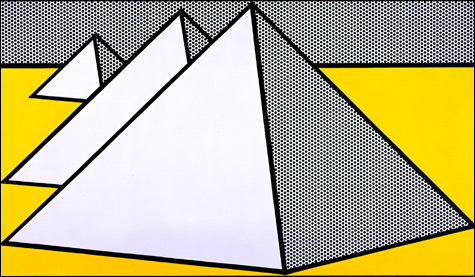A “Re-View” of the last 100 years at RISD
By BILL RODRIGUEZ | January 2, 2007

POP ART: Roy Lichtenstein’s “Pyramids II” [1969]. |
The advantage of being a teaching museum is on full display at the Rhode Island School of Design in the exhibition “Re-Viewing the Twentieth Century.” Drawing nearly 100 examples from its permanent collections of more than 84,000 works, the RISD Museum is presenting a comprehensive survey of modernist and contemporary artists and some of their inspiring predecessors.
From a landscape painting by Paul Cézanne to a wall-filling silhouette mural by contemporary artist Kara Walker, the exhibition incorporates many media and categories, from photographs to video loops to decorative arts such as textiles and furniture.
“We tried to get our best things out and put them in context so that they spoke to one another,” said Maureen O’Brien, who headed a team of the museum’s curators that selected the show. As curator of painting and sculpture, she is in charge of the period from the Middle Ages to 1960.
“We now have Latin American art that museums can’t acquire for love nor money,” she said, walking by Argen¬tinian Jorge de la Vega’s image-dense mixed media on canvas, “History of the Vampires (Historia de los vampiros)” (1963).
Selecting the most relevant works was only part of their task. “I also had this very daunting issue of how to represent a hundred years of modern art in the 20th century, which really starts with works that spring off the end of the 19th century and then ends up with art that people find difficult because it’s so abstract,” she continued. “Minimalist art is so much more difficult for some people than painting with narrative or objects you can identify. It’s always an issue, I think.”
Since there were so many themes and concerns in the century’s art movements, a less confusing way to organize the show was with four questions. Works in four galleries collectively ask: “Who are we?,” “How did we get here?,” “What happens to Art?” and “Why is it Art?”
That last question, perhaps the most relevant one to casual viewers, is brought up immediately as one enters the Farago Wing entrance. In the high-ceilinged entry space, the question isn’t answered, of course, on the informational wall card that brings up the matter. Instead, the questioning itself is incorporated into what the displayed art accomplishes.
“When people come in and see a Sol LeWitt sculpture or a Cy Twom¬bly painting, many people still will say, ’Well, why are scribbles on a blackboard art?’ ” O’Brien said as she looked around the gallery. “We are not afraid of the question.”
 Related
Related:
Out of the shadows, Going underground, Random stuff, More 
- Out of the shadows
Although “Wunderground: Providence, 1995 to the Present,” an exhibition that opened last weekend at the Rhode Island School of Design Museum, covers a brief period of time, it also represents a dramatically compressed cycle of change in the life of the city. Images from the Wunderground Print the legend: Providence's "Wunderground" and MassArt's "Crafty." By Greg Cook
- Going underground
The project in which Michael Townsend and seven collaborators created a secret apartment at Providence Place began as an adventure in which four friends tried to live in the mall for a week.
- Random stuff
If you were going to create a portrait of the Internet, what would it look like?
- Art retains its power to push our buttons
When a French artist submitted a signed urinal to the Society of Independent Artists, some might think that this was just another battlefront in the culture wars.
- RISD redefined
Rhode Island School of Design’s new Chace Center is the physical embodiment of the 131-year-old institution’s effort to rebrand itself as a more open place.
- Brave new RISD
The Rhode Island School of Design, for all its artful ambition, is a conservative place. Students draw. They mold clay. They are awash in taxidermy. So there was more than a little anxiety when John Maeda — sneaker designer, MIT professor, digital media rock star — took over as RISD president last summer.
- Cracking the code
The idea that the viewer contributes to a work of art doesn’t seem as visionary as it did in the early 20th century when the Berlin and New York schools of Dada were hammering out new ways of seeing and expressing.
- Print the legend
This exhibit offers an eye-popping, floor-to-ceiling survey of practically every poster produced to advertise under-the-radar Providence shenanigans from 1995 to 2005. Slideshow: Images from Wunderground
- Limits of non-traditional leadership
John Maeda arrived at the Rhode Island School of Design a year ago pledging a different sort of leadership.
- States of the art
In New England, where you can't swing a sack of cranberries without hitting a venerable cultural institution, anyone with access to a car (or even a subway pass) can scope out these topnotch art museums.
- Next. Now
Shows like this are, by their nature, big messy buffets.
- Less

 Topics
Topics:
Museum And Gallery
, Painting, Visual Arts, Cultural Institutions and Parks, More  , Painting, Visual Arts, Cultural Institutions and Parks, Museums, Rhode Island School of Design, Marcel Duchamp, Roy Lichtenstein, Joseph Cornell, Jackson Pollock, Sol LeWitt, Less
, Painting, Visual Arts, Cultural Institutions and Parks, Museums, Rhode Island School of Design, Marcel Duchamp, Roy Lichtenstein, Joseph Cornell, Jackson Pollock, Sol LeWitt, Less 